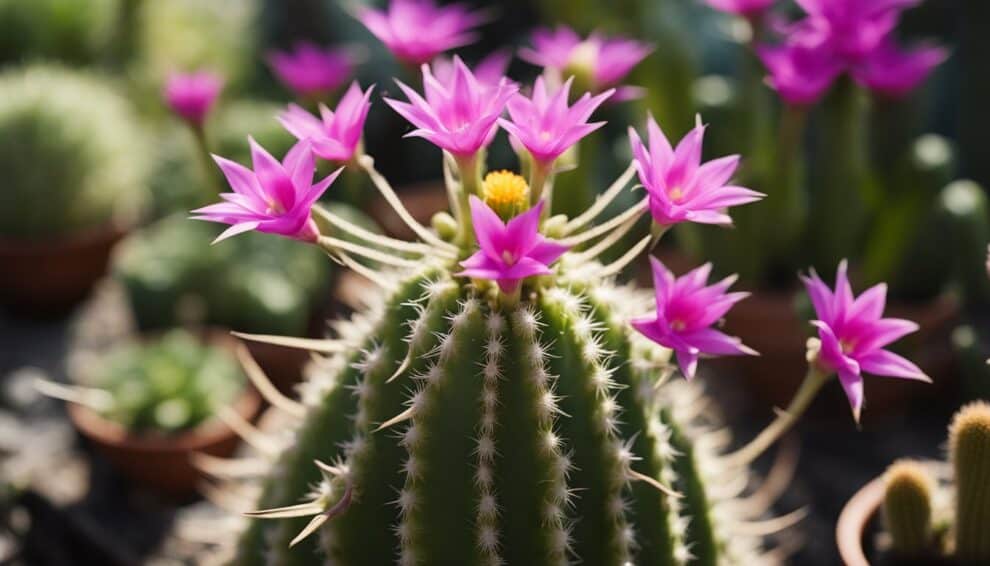Alien Blooms: Starfish Flower Cactus (Stapelia grandiflora) Propagation

For plant enthusiasts, the Starfish Flower Cactus (Stapelia grandiflora) is a unique and fascinating plant that is sure to pique their interest. Its striking appearance, with its large, star-shaped flowers that resemble a starfish, is a sight to behold. This plant is native to South Africa and is a member of the Apocynaceae family.
One of the most interesting aspects of the Starfish Flower Cactus is its propagation process. Unlike other plants, it requires a bit of extra care and attention to propagate successfully. However, with the right knowledge and techniques, plant lovers can easily propagate this unique cactus and enjoy its beautiful blooms in their own homes. In this article, we will explore the process of propagating the Starfish Flower Cactus and provide tips and tricks to ensure success.
Understanding Stapelia Grandiflora
Characteristics of Starfish Flower Cactus
Stapelia grandiflora, commonly known as the Starfish Flower Cactus, is a succulent plant that belongs to the Apocynaceae family. This plant is native to South Africa and is known for its unique and stunning star-shaped flowers. The flowers are large, up to 30 cm in diameter, and are characterized by their fleshy petals that are covered in hair-like structures. The flowers are also known for their strong and unpleasant odor, which is similar to that of rotting meat. This odor attracts flies, which are the plant’s primary pollinators.
The Starfish Flower Cactus has a thick, fleshy stem that is covered in small bumps or warts. The stem can grow up to 30 cm in height and 10 cm in diameter. The plant also has small, spine-like structures on the stem, which help to protect it from predators.
Ideal Growing Conditions
The Starfish Flower Cactus is a relatively easy plant to grow, as long as it is given the right growing conditions. This plant prefers well-draining soil that is rich in organic matter. It also requires bright, indirect sunlight, as direct sunlight can scorch the leaves and flowers.
The plant should be watered sparingly, as overwatering can cause the roots to rot. It is recommended to let the soil dry out completely between waterings. The plant also benefits from occasional fertilization during the growing season.
The Starfish Flower Cactus can be propagated from stem cuttings, which should be taken during the plant’s active growing season. The cuttings should be allowed to dry out for a few days before being planted in well-draining soil.
Overall, the Starfish Flower Cactus is a unique and beautiful plant that can add a touch of exotic beauty to any garden or indoor space. With the right growing conditions and care, this plant can thrive and produce stunning flowers for years to come.
Propagation Methods

Seed Propagation
Stapelia grandiflora can be propagated by seeds. The seeds should be collected from the ripe fruits and sown in well-draining soil. The soil should be kept moist, but not waterlogged. The seeds should germinate within two to four weeks.
Cuttings Propagation
Stapelia grandiflora can also be propagated by cuttings. The cuttings should be taken from the stem of the plant and allowed to dry for a few days. The cuttings should then be planted in well-draining soil and kept moist. The cuttings should root within a few weeks.
Propagation by cuttings is the most common method used for propagating Stapelia grandiflora, as it is easier and more reliable than seed propagation. However, seed propagation can be a fun and rewarding way to propagate the plant for those who enjoy gardening.
Overall, both seed and cuttings propagation methods can be successful in propagating Stapelia grandiflora. It is important to ensure that the soil is well-draining and kept moist, but not waterlogged, to ensure successful propagation.
Caring for Young Plants

Soil and Potting
When it comes to soil, the Starfish Flower Cactus prefers a well-draining mix with plenty of organic matter. A mix of potting soil, sand, and perlite in a 2:1:1 ratio works well. It’s important to choose a pot that is just slightly larger than the plant’s root ball to avoid overwatering. Repotting should only be done when the plant has outgrown its current container.
Watering and Feeding
The Starfish Flower Cactus is drought-tolerant and prefers to be watered sparingly. Overwatering can lead to root rot and other issues. Water the plant only when the top inch of soil is dry to the touch. During the growing season, fertilize the plant every 2-3 weeks with a balanced fertilizer diluted to half strength.
Sunlight and Temperature
The Starfish Flower Cactus prefers bright, indirect sunlight. Direct sunlight can scorch the leaves and cause damage. A south-facing window with a sheer curtain or a bright, east-facing window is ideal. The plant prefers warm temperatures between 60-80°F (15-27°C). Avoid placing the plant near cold drafts or air conditioning vents.
Overall, with proper care and attention, young Starfish Flower Cactus plants can thrive and produce stunning blooms.
Frequently Asked Questions

What are the ideal conditions for propagating Stapelia grandiflora cuttings?
Stapelia grandiflora cuttings can be propagated in a warm and dry environment with bright but indirect light. A temperature range of 60-80°F (15-27°C) is ideal. It is important to keep the soil mixture moist but not too wet during the propagation process.
How long does it take for a starfish cactus cutting to root?
It can take anywhere from 2-6 weeks for a Stapelia grandiflora cutting to root, depending on the temperature and humidity levels. It is important to be patient during this process and avoid disturbing the cutting until it has rooted.
Can you propagate Stapelia grandiflora in water, and if so, how?
Stapelia grandiflora can be propagated in water, but it is not recommended as it can lead to rotting of the cutting. It is best to use a well-draining soil mixture and keep the soil moist but not too wet.
What soil mixture is best for rooting Stapelia cactus cuttings?
A well-draining soil mixture consisting of sand, perlite, and peat moss is ideal for rooting Stapelia grandiflora cuttings. It is important to avoid using heavy or compacted soil mixtures as they can lead to root rot.
How often should I water Stapelia cuttings during the propagation process?
It is important to keep the soil mixture moist but not too wet during the propagation process. Watering once a week or when the soil feels dry to the touch is recommended.
What are some common issues when propagating Stapelia grandiflora and how can I avoid them?
Common issues when propagating Stapelia grandiflora include overwatering, root rot, and fungal infections. To avoid these issues, it is important to use a well-draining soil mixture, avoid watering too frequently, and keep the cutting in a warm and dry environment with bright but indirect light.













